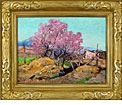

Artist Biography Joseph Pierre Birren (1864 – 1933) was born in Chicago, Illinois on May 14, 1864 the youngest son of Henry and Catherine Birren. The Birrens had arrived in Chicago in 1848 from Luxembourg, having first spent three hard years in Buffalo, New York.After an education in private schools Birren got a position, at age eighteen, as assistant to a crayon portrait painter. From there he went into the studio of C. F. Schwerdt, a portrait painter of some renown. Birren succeeded J. H. Vanderpoel as general handy-boy about the studio. He had the opportunity to assist in portrait work from photographs and to begin his actual experience in painting from a model. Just one year later, in 1883, Birren began his formal art education as a student in the newly organized classes of the Art Institute of Chicago, studying under the same John Vanderpoel whom he had replaced in Schwerdt’s portrait studio. In 1885 Birren was engaged by Henry Knight to assist in the creation and execution of a cyclorama painting of the Battle of Gettysburg. The event marked the first great and significant commission of his life. It won for him instant recognition as a young man of exceptional ability. He was the only painter of the staff who could achieve the task of making a dead soldier look dead! In 1886 Birren was commissioned by H. H. Gross to work on another, even larger cyclorama. In the painting of this massive canvas, some 365 feet in length, Birren was associated with a group of rising young artist, J. H. Twachtman, C. H. Collins, Arthur B. Davies, Warren Davis, Oliver Dennet Grover, F. C. Peyraud and Harry Vincent. In 1888 Birren, together with C. H. Collins and C. Wilhelmi, took the cyclorama to first Sydney and then Melbourne, Australia and installed it for exhibition. Following a year in Australia, Birren traveled to Paris where he lived in the Latin Quarter while studying first at the Callorasi and then the Académie Julian. In this manner he was able to study with Constant, Lefebvre, Courtois and Falguiere during his year in Paris. During 1890, 1891 and part of 1892 Birren worked in New York City as a newspaper illustrator in the era before the photographic halftone. Returning to Chicago in 1892 Birren was made Chief of the Art Staff of the Chicago Graphic for the entire period of the Chicago World’s Fair. After working for J. Manz & Co. from 1894, Birren decided to go into business for himself in 1899, establishing Graphic Arts Company of which Sears, Roebuck was a client. He stayed with this endeavor until 1916 when he retired from commercial art. Birren was now free to devote his life to “art for art’s sake.” He had previously spent a season painting in Bermuda as well as several seasons at Provincetown on Cape Cod and other summers in New England. Commissioned by a wealthy patron and collector to paint landscapes near Monterey, Birren closed up his studio home in Chicago and set off for California in 1925. His works from that trip includes depictions of Yosemite and Southern California as well as the Monterey Peninsula. He spent some part of 1927 in Santa Fé, New Mexico where his atmospheric and impressionistic landscapes received a positive reception in the local press. Joseph Pierre Birren died at the age of 69 on August 4, 1933 in Sacred Heart Sanitarium in Milwaukee where he had been a patient of six weeks. He was survived by his wife, Crescentia Lang Birren, two sons, William and Faber, and a daughter, Jeannette. Birren is represented in the collections of the Museum of New Mexico, Santa Fé, the Monterey Peninsula Museum of Art, the Los Angeles County Museum of Art, the Washington University Gallery of Art, the Pasadena Art Museum, the Illinois State Museum, the Chicago Municipal Collection and the Luxembourg Museum in Paris. Work Available For Sale |
 |  | |
© Scanlan Fine Arts Gallery • All rights reserved |